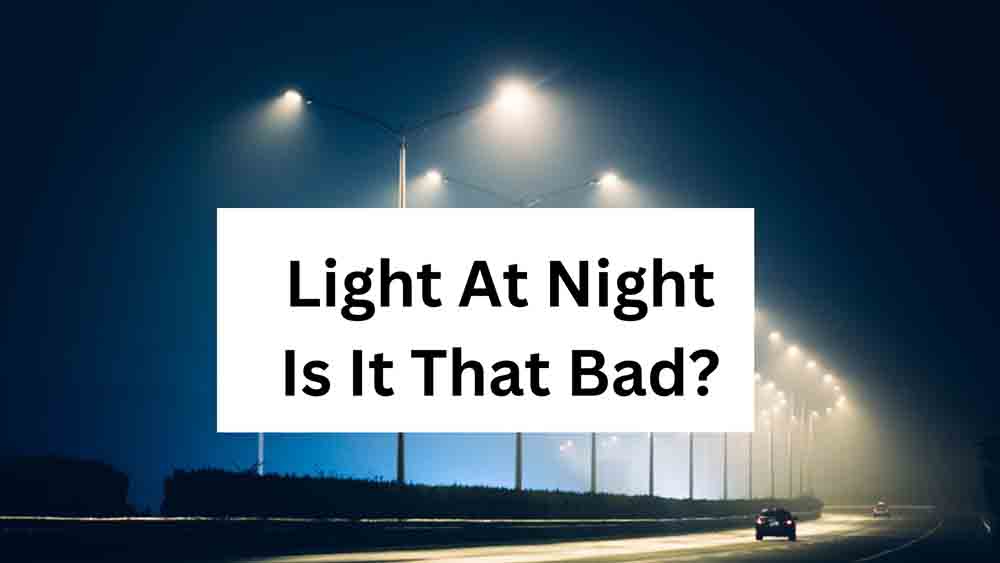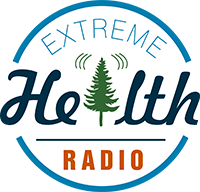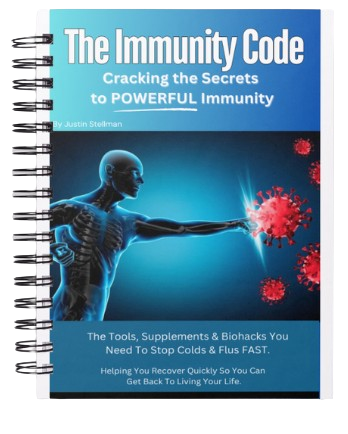Podcast: Play in new window | Download (Duration: 40:12 — 16.1MB) | Embed
Subscribe: Apple Podcasts | Spotify | Android | iHeartRadio | RSS | More

Is light at night bad for you?
The answer is definitely yes.
The short answer as to why light at night is bad is because it suppresses your melatonin levels and alters your circadian rhythm. Not good if you want to heal with optimal sleep.
I go into full detail here about how I mitigate light at night and embrace natural light frequencies during the day.
Why Light At Night Is Dangerous
Attenuation of short wavelengths alters sleep and the ipRGC pupil response
“The use of short wavelength-blocking glasses at night increased subjectively measured sleep quality and objectively measured melatonin levels and sleep duration, presumably as a result of decreased night-time stimulation of ipRGCs. Alterations in the ipRGC-driven pupil response suggest a shift in circadian phase. Results suggest that minimizing short wavelength light following sunset may help in regulating sleep patterns.” – Source
Blue light from light-emitting diodes elicits a dose-dependent suppression of melatonin in humans
“..light suppresses melatonin most effectively in the short-wavelength portion of the spectrum (446-477 nm).” – Study
Green Light Attenuates Melatonin Output and Sleepiness during Sleep Deprivation
“Humans are particularly sensitive to green light, and melatonin output is more readily suppressed by this hue”.
“Melatonin output is more readily suppressed by [green light] than by various other hues of the same intensity. For example, the suppression is about 75% greater than for light of 600 nm (orange-red)” – Source
Putting cancer to sleep at night
The neuroendocrine/circadian melatonin signal
It has been postulated that in industrialized societies, light at night, by suppressing melatonin production, poses a new risk for the development of breast cancer and, perhaps, other cancers as well. Dietary melatonin supplementation working in concert with the endogenous melatonin signal has the potential to be a new preventive/therapeutic strategy to optimize the host/cancer balance in favor of host survival and quality of life. – Source
Artificial light at night and melatonin–is it the missing link?
“The use of artificial light at night tricks the body into believing that it is still daytime. The special photoreceptors in the eye […] send signals to the pineal gland which suppresses the production of melatonin. Thus, the onset of melatonin production is pushed back later into the evening […] reducing the amount of melatonin that the body produces, which can negatively affect health”.
“Melatonin has been shown to be protective against the development and spread of cancer […] through the suppression of melatonin production, it increases the probability that cancer cells can survive and spread”. – Source
Light at night and modeled circadian disruption predict higher risk of mortality: A prospective study in >88,000 participants
Minimizing exposure to light at night and keeping regular light-dark patterns that enhance circadian rhythms may promote cardiometabolic health and longevity. – Study
Bright Lights, Big Cancer – Melatonin-depleted blood spurs tumor growth
“Light at night is now clearly a risk factor for breast cancer,” Blask says. “Breast tumors are awake during the day, and melatonin puts them to sleep at night.” Add artificial light to the night environment, and “cancer cells become insomniacs,” he says.
“Sleep per se is not important for melatonin,” says Russel J. Reiter, a neuroendocrinologist at the University of Texas Health Science Center in San Antonio. “But darkness is.”
The new study has far-reaching implications, says Reiter. First, it could spawn trials that test whether malignancies can be slowed down by altering a person’s light environment or by using melatonin supplements. Second, he says, similar studies could show whether exposure to nocturnal light poses a prostate cancer risk to men, as some researchers suspect, or promotes other cancers previously linked to light at night (SN: 8/28/04, p. 141: Available to subscribers at Bright nights kindle cancers in mice).
“Breast cancer is epidemic in the world. It’s increasing everywhere,” says Stevens. It’s most prevalent in industrialized countries, where electric lights are widely used, he says. “It’s increasing very rapidly in places that are industrializing,” he adds.
Furthermore, compared with other workingwomen, female night-shift workers have about a 50 percent greater risk of developing breast cancer, says William Hrushesky of Dorn Veterans Affairs Medical Center in Columbia, S.C. – Source
NTP Cancer Hazard Assessment Report on Night Shift Work and Light at Night
Conclusion: Artificial light at night is a significantly correlated for all forms of cancer including lung, breast, colorectal, and prostate cancer. Immediate measures should be taken to reduce artificial light at night in the main cities around the world. – Source
The Circadian Clock Controls Sunburn Apoptosis and Erythema in Mouse Skin
“excessive light at night and insufficient light during the day as “reasonably anticipated to be a human carcinogen” – Source
Personal light exposure patterns and incidence of type 2 diabetes: analysis of 13 million hours of light sensor data and 670,000 person-years of prospective observation
Over 13 million human light hours tracked and the findings conclude:
“The difference in diabetes risk between people with bright and dark nights was similar to the difference between people with low and moderate genetic risk. Type 2 diabetes risk was higher in people exposed to brighter night light, and in people exposed to light patterns that may disrupt circadian rhythms. Avoidance of light at night could be a simple and cost-effective recommendation that mitigates risk of diabetes, even in those with high genetic risk.” – Source
Light Exposure at Night Disrupts Host/Cancer Circadian Regulatory Dynamics: Impact on the Warburg Effect, Lipid Signaling and Tumor Growth Prevention
“Dim light at night (LAN)-induced melatonin suppression disrupts this circadian-regulated host/cancer balance among several important cancer preventative signaling mechanisms, leading to hyperglycemia and hyperinsulinemia in the host and runaway aerobic glycolysis, lipid signaling and proliferative activity in the tumor.” – Source
Association of Exposure to Artificial Light at Night While Sleeping With Risk of Obesity in Women
These results suggest that exposure to ALAN while sleeping may be a risk factor for weight gain and development of overweight or obesity. Further prospective and interventional studies could help elucidate this association and clarify whether lowering exposure to ALAN while sleeping can promote obesity prevention. – Source
Association between light at night, melatonin secretion, sleep deprivation, and the internal clock: Health impacts and mechanisms of circadian disruption
Shift and/or night work generally decreases the time spent sleeping, and it disrupts the circadian time structure. In the long run, this desynchronization is detrimental to health, as underscored by a large number of epidemiological studies that have uncovered elevated rates of several diseases, including cancer, diabetes, cardiovascular risks, obesity, mood disorders and age-related macular degeneration. – Source
Artificial Light at Night and Cancer: Global Study
January- June 2015 on secondary data from 158.0 countries.
Recently, light pollution in the form of artificial light at night (ALAN) has been detected to cause breast cancer, melatonin being the mediator between environment and the epigenome (Yang et al., 2014; Haim and Zubidat 2015). ALAN can also increase the risk of colorectal cancer in night shift workers (Schernhammer et al., 2001). ALAN not only adversely effects humans directly exposed to it, but it also affects the ‘protected areas’, undisturbed natural habitat of flora and fauna, vital to the human existence and well being (Aubrecht et al., 2010).
Age standardized incidence rate (ASR) of all forms of cancer, lung cancer, breast cancer, colorectal cancer and prostate cancer were significantly positively correlated with Protected Area Light Pollution Indicator (PALI) and PAHI, stronger for Protected Area Human Influence Indicator (PAHI). When adjusted for population size, electricity consumption, air pollution, and total land area of the country covered by forest, the positive association remained significant for PALI with colorectal cancer and for PAHI with all forms of cancers, lung cancer and breast cancer
This study found that artificial light at night leads to cancer causation in humans, even after adjusting for population size, particulate matter representing air pollution, electricity consumption at national levels, and the land area covered by forests. This may be due to the disruption of circadian system by exposing to much light at night and this is can be generalized to the whole population and not only to certain occupational groups such as nurses. Another possible explanation is that the connection of artificial light at night with melatonin hormone which produced in nighttime darkness that promote sleep. Therefore, exposure to night light may suppress the release of melatonin which typically peaks in the middle of the night.
Conclusion: Artificial light at night is a significantly correlated for all forms of cancer including lung, breast, colorectal, and prostate cancer. Immediate measures should be taken to reduce artificial light at night in the main cities around the world. – Source
How Much Light At Night Is Too Much?
Melatonin Suppression by Light in Humans Is More Sensitive Than Previously Reported
the threshold for human melatonin suppression is approximately 10 log photons cm–2 s–1 at 460 nm wavelength. – Source
Circadian phase resetting by a single short-duration light exposure (photon)
Twenty-six healthy individuals participated in a 9-day inpatient protocol that included assessment of dim light melatonin onset time before and after exposure to a single 15-second or 2-minute pulse of bright light (9,500 lux; 4,100 K fluorescent) or control background dim light. Both 15 second and 2-minute exposures induced phase delay shifts of –34.8 ± 47.2 minutes and –45.4 ± 28.4 minutes, respectively, that were significantly (P = 0.04) greater than the control condition. These findings may have real-world implications for circadian disruption induced by exposure to brief light stimuli at night. – Source
Testing the Limits of Human Vision with Single Photons
We discuss techniques using a heralded single-photon source to study the lower limit of human vision, and report some preliminary results, including a measurement of temporal integration at the few-photon level. – Source
Are Nightlights Bad?
Bedroom Light Exposure at Night and the Incidence of Depressive Symptoms: A Longitudinal Study of the HEIJO-KYO Cohort
“In conclusion, these results indicated that exposure to LAN (light at night) in home settings was independently associated with subsequent depression risk…” – Source
Exposure to Room Light before Bedtime Suppresses Melatonin Onset and Shortens Melatonin Duration in Humans
“…chronically exposing oneself to electrical lighting in the late evening disrupts melatonin signaling and could therefore potentially impact sleep, thermoregulation, blood pressure, and glucose homeostasis.” – Source
Bedroom lighting environment and incident diabetes mellitus: a longitudinal study of the HEIJO-KYO cohort
“The study found that people exposed to light levels of 5 lux or more at night had a significantly higher chance of developing diabetes compared to those exposed to less than 5 lux. In fact, their risk was about 3.7 times higher.” – Source
Could More Sunlight Help You Live Longer?
“People who slept with the lights on in their bedroom at night died at a 30 percent faster rate, as compared to those who slept in pitch darkness. And deaths from cardiovascular (heart attacks) and metabolic (diabetes) diseases increased by 40 percent.” – Source
How Can You Protect Yourself?
To fix this light at night issue I recommend using only special circadian lighting from BonCharge or Healthy Home Shop and wearing blue blocking glasses.
My morning and daily practice is as follows….
- Watch the sunrise (grounded of course)
- Block blue light during the day with yellow glasses and Iris Tech
- Open windows as much as possible
- Get outside as much as possible during the day (1 min is enough)
- Watch the sunset
- After sunset turn computer screen to orange with Iris and put on orange glasses
- 2 hours before bed put on my red glasses
- No blue light at night at all
- Currently taking 50mg of melatonin before bed
The takeaway is to mitigate your light environment as much as possible.
Embrace the light during the day and accentuate the darkness at night!
The other thing to note is LED lighting from indicator lights in our bedrooms or homes.
I wanted to send you this info about green light. Did you know that green light coming from indicator lights in our bedroom at night can also inhibit melatonin?
Melatonin is your #1 anti cancer hormone you make. I supplement it but, I also make it daily by watching the sunrise and getting outdoors.
How you can fix this!
I use Junk Light Dots and cover all of them up all over the house. You can see me doing it here! 🙂
Not only is light at night not ideal but it also can lead to disease.
Only you can fix this!
Conclusion
As you can see light at night is very dangerous to your health and should be avoided if at all possible.
Questions:
- What’s your light environment like?
- What do you do to block blue light at night?
- Have you noticed any differences in sleep or overall health?
Comment below!


